What's New
Displaying results 1921 - 1930 of 4899
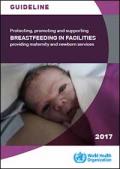
Resource | Guidelines,
This guideline provides global, evidence-informed recommendations on protection, promotion and support of optimal breastfeeding in facilities providing maternity and newborn services, as a public health intervention. It is intended to contribute to discussions among stakeholders when selecting or prioritizing appropriate actions in their efforts to achieve the Sustainable Development Goals and the global targets for 2025 as put forward in the Comprehensive implementation plan on maternal, infant and young child nutrition, endorsed by the Sixty-fifth World Health Assembly in 2012, in resolution WHA65.6, the Global strategy for women’s, children’s, and adolescents’ health (2016–2030), and the Global Strategy for infant and young child feeding.
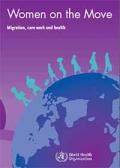
Resource | Publications,
A global paradox is emerging in which care workers - who are largely migrant women, often working in informal home settings - make a considerable contribution to public health in many countries but are themselves exposed to health risks, face barriers to accessing care, and enjoy few labour and social protections.
WHO has produced a new report on this population group, collating evidence across sectors. This report breaks new ground in casting a wide net across disciplines – health, labour, employment, social protection, social services, law, immigration, cross-border movement and citizenship – to shed light on a particular population group that both provides care as well as needs it to maintain their own health and well-being. It looks at the lives of these migrant women care workers as well as the situation for their households left behind. It takes a transnational perspective appropriate to our interconnected world.
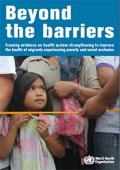
Resource | Publications,
"Leaving no one behind" is a centrefold principle in the Sustainable Development Agenda. Those "left behind" are a vastly heterogeneous group. They face a wide range of barriers to health services that differ across countries, communities and individuals. As such, approaches to health system strengthening to leave no one behind need to account for this heterogeneity and the complexity of barriers. Some migrants, in particular those experiencing poverty and social exclusion, face intersecting and compounding barriers.
This paper emphasizes that leaving no one behind entails full realization of human rights, without discrimination on the basis of sex, age, race, colour, language, religion, political or other opinion, national or social origin, property, birth, disability or other status.
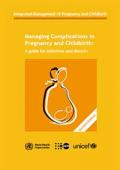
Resource | Guidelines,
Since the first edition was published in 2000, Managing Complications in Pregnancy and Childbirth has been translated into several languages and today is used widely in training for and the provision of emergency obstetric care. The new edition brings the guidance in the manual into line with WHO’s current recommendations for emergency obstetric and newborn care.
While most pregnancies and births are uneventful, all pregnancies are at risk. Around 15% of all pregnant women will develop a potentially life-threatening complication that calls for skilled care, and some will require a major obstetrical intervention to survive. This manual is written for midwives and doctors at the district hospital who are responsible for the care of women with complications of pregnancy, childbirth or the immediate postpartum period, including immediate problems of the newborn.
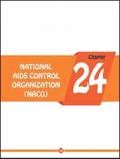
Resource | Publications,
The NACP-IV (2012-2017) has entered in the last year of its implementation. NACP-IV aims to consolidate the gains made till now while making further strides with a goal of accelerating reversal and integrating response. NACP-IV had two objectives - Reduce new infections by 50% (2007 Baseline of NACP-III) and provide comprehensive care and support to all persons living with HIV/AIDS and treatment services for all those who require it.
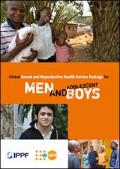
Resource | Publications,
The Global Sexual and Reproductive Health Service Package for Men and Adolescent Boys has been developed to support providers of sexual and reproductive health services. It aims to increase the range and quality of sexual and reproductive services provided that meet the specific and diverse needs of men and adolescents boys. It covers men and adolescent boys in all their diversity, and takes a positive approach to sexual and reproductive health, seeing this not just as the absence of disease, but the positive expression of one’s gender, sex and sexuality.
In doing so, this service package contributes to efforts to ensure universal access to sexual and reproductive health and rights (SRHR) as prioritized in the Sustainable Development Goals. This package is in no way intended to detract from the sexual and reproductive health and rights of women and adolescent girls, nor to divert resources, funding or attention from much-needed SRH services and programmes for women and adolescent girls.
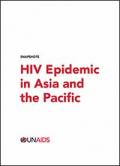
Resource | Reviews and Snapshots,
UNAIDS Snapshot 2017: HIV epidemic in Asia and the Pacific is an interactive report with colourful infographics and bite-size information on the HIV epidemic and response on key populations at higher risk of HIV in Asia and the Pacific.

Resource | Publications,
In this year's AVAC Report—Mixed Messages and How to Untangle Them—we have set ourselves the task of clarifying the profoundly complex field of biomedical HIV prevention and research. This is never an easy task, but it is made all the more complicated— and exciting—in the current environment.
One definition of "mixed message" is "a showing of thoughts or feelings that are very different from one another." Based on this, the term "biomedical prevention" is itself a mixed message, since it suggests that there are prevention strategies that can be extricated from the messy reality of human behavior, social relations and structural arrangements that preserve and exacerbate inequalities. As the Global Forum on MSM & HIV points out, all biomedical options are fundamentally social in that they involve relationships with our bodies, partners, clinics, communities and countries.
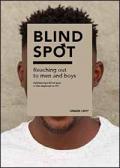
Resource | Publications,
In a world of gender inequalities that disadvantage women and girls, publishing a report on how men are not being reached by health services and are not exercising their right to health may seem counterintuitive. It was indeed perplexing to learn that men were less likely than women to know their HIV status and less likely to access and adhere to HIV treatment. As a consequence, more men are likely to die of AIDS-related illnesses than women. As the world strives to reach the high levels of HIV service coverage required to end AIDS as a public health threat, this blind spot in the response to HIV can no longer be ignored.
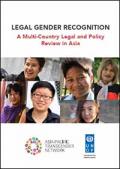
Resource | Publications,
The vast majority of transgender people across the Asia-Pacific region are unable to obtain any official identification documents that reflect their gender identity. This lack of gender recognition fosters widespread social exclusion, stigma, discrimination and violence when individuals are perceived to deviate from gender norms because their gender identity and/or expression does not coincide with their sex assigned at birth.
This report, Legal Gender Recognition: A Multi-Country Legal and Policy Review in Asia, undertakes a comprehensive review of existing laws, policies and practices related to legal gender recognition for transgender people in nine countries in Asia: Bangladesh, China, India, Indonesia, Malaysia, Nepal, Pakistan, Philippines and Thailand.





